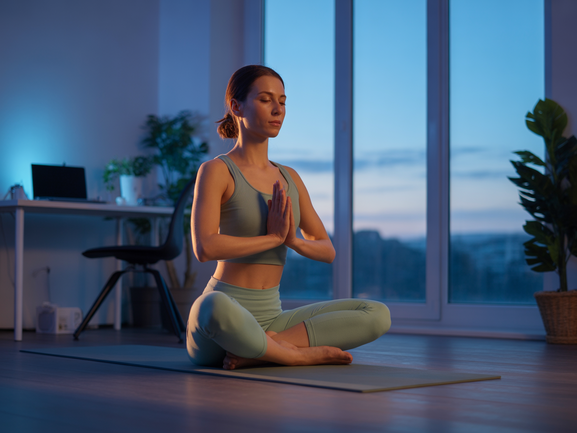Yoga for Career Transition: Find Balance During Professional Change
Career transitions can feel like standing at the edge of a cliff, unsure whether to leap or step back. The uncertainty, stress, and overwhelming emotions that accompany professional changes affect not just our minds but our entire bodies. If you’re navigating a career transition right now, you’re not alone in feeling physically tense, mentally scattered, or emotionally drained.
What if there was a way to transform this challenging period into an opportunity for growth and self-discovery? Enter yoga for career transition – a powerful practice that helps professionals like you find stability, clarity, and confidence during times of change.
Why Career Transitions Create Physical and Mental Stress
During professional transitions, our bodies often become storage units for stress and anxiety. Research from the American Psychological Association shows that workplace stress significantly impacts our physical wellbeing, leading to:
- Muscle tension in shoulders, neck, and back
- Disrupted sleep patterns
- Digestive issues from chronic stress
- Decreased immune function
- Mental fog and decision-making difficulties
Furthermore, the uncertainty of career change triggers our fight-or-flight response, keeping us in a constant state of alertness that’s exhausting for both mind and body.
How Yoga Supports Mindful Career Change
Yoga isn’t just about flexibility – it’s a comprehensive system for managing stress and building resilience. When applied to career transition, yoga offers several key benefits:
1. Stress Regulation Through Breathwork
Controlled breathing techniques help activate your parasympathetic nervous system, naturally reducing cortisol levels and promoting calm decision-making. This is crucial when evaluating job offers or making strategic career moves.
2. Enhanced Mental Clarity
Regular body movement meditation practices clear mental clutter, allowing you to see opportunities and solutions more clearly. Many professionals report breakthrough moments during or after yoga sessions.
3. Building Emotional Resilience
Yoga teaches us to observe our thoughts and emotions without judgment, developing the emotional intelligence needed to navigate workplace challenges and professional relationships.
7 Essential Yoga Poses for Career Transition Relief
Here are specific poses designed to address the common physical and mental challenges of career change:
1. Mountain Pose (Tadasana) – Grounding and Confidence
This foundational pose helps you feel stable and centered, perfect for building confidence before interviews or important career conversations.
2. Child’s Pose (Balasana) – Stress Relief
When career anxiety peaks, this restorative pose activates your body’s relaxation response, providing immediate stress relief for professionals.
3. Eagle Pose (Garudasana) – Focus and Determination
This balancing pose improves concentration and mental focus, essential skills when researching new opportunities or preparing for career pivots.
4. Warrior II (Virabhadrasana II) – Strength and Courage
Build inner strength and courage to face career challenges head-on with this empowering standing pose.
5. Seated Forward Fold (Paschimottanasana) – Introspection
This calming pose encourages inward reflection, helping you connect with your true career aspirations and values.
6. Bridge Pose (Setu Bandhasana) – Opening to New Possibilities
Heart-opening poses like bridge help release emotional blockages and create space for new opportunities.
7. Legs-Up-The-Wall Pose (Viparita Karani) – Recovery and Renewal
End your practice with this restorative pose to reset your nervous system and prepare for restful sleep.
Creating Your Career Transition Yoga Routine
Consistency is key when using yoga to support career change. Consider these practical tips:
- Morning Practice: Start with 10-15 minutes of energizing poses to set a positive tone
- Midday Reset: Use breathing exercises during lunch breaks to manage stress
- Evening Wind-Down: Practice restorative poses to process the day’s events
The beauty of online yoga platforms like Vitalizen.app is that you can access guided sessions anytime, anywhere – perfect for busy professionals managing career transitions.
Integrating Mindfulness into Your Career Journey
Beyond physical poses, mindful career change involves bringing awareness to your professional decisions. Consider these practices:
- Meditation before important career conversations
- Body scanning to notice stress signals during work
- Mindful networking – being present during professional interactions
- Gratitude practices to maintain positive perspective during challenges
Research from Harvard Medical School demonstrates that mindfulness practices significantly reduce workplace stress and improve job satisfaction.
Why Vitalizen is Perfect for Career Transition Support
At Vitalizen.app, we understand that career transitions require flexible, accessible wellness solutions. Our platform offers:
- Specialized programs for workplace stress yoga
- Short, effective sessions that fit busy schedules
- Expert guidance from certified instructors
- Progress tracking to maintain consistency
- Community support from other professionals on similar journeys
Whether you’re dealing with job loss, career change, or professional growth challenges, our tailored approach helps you maintain balance and clarity throughout your transition.
Frequently Asked Questions
How often should I practice yoga during career transition?
For optimal stress relief and mental clarity, aim for 3-4 sessions per week, even if they’re just 15-20 minutes each. Consistency matters more than duration.
Can yoga really help with career anxiety?
Yes, yoga’s combination of movement, breathwork, and mindfulness has been scientifically proven to reduce anxiety and improve emotional regulation – key skills for navigating career uncertainty.
What if I’m too busy for regular yoga practice?
Start with just 5-10 minutes of breathing exercises or simple stretches

